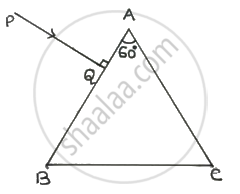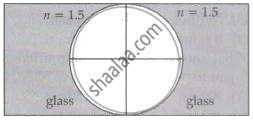Advertisements
Advertisements
प्रश्न
A prism is made of glass of unknown refractive index. A parallel beam of light is incident on the face of the prism. The angle of minimum deviation is measured to be 40°. What is the refractive index of the material of the prism? The refracting angle of the prism is 60°. If the prism is placed in water (refractive index 1.33), predict the new angle of minimum deviation of a parallel beam of light.
उत्तर
Angle of minimum deviation, δm = 40°
Angle of the prism, A = 60°
Refractive index of water, µ = 1.33
Refractive index of the material of the prism = µ'
The angle of deviation is related to refractive index (µ') as:
µ' = `(sin (("A" + δ_"m"))/2)/(sin "A"/2)`
= `(sin ((60° + 40°))/2)/(sin (60°)/2)`
= `(sin 50°)/(sin 30°)`
= 1.532
Hence, the refractive index of the material of the prism is 1.532.
Since the prism is placed in water, let `δ_"m"^"'"` be the new angle of minimum deviation for the same prism.
The refractive index of glass with respect to water is given by the relation:
`μ_"g"^"w" = (μ"'")/μ = (sin (("A" + δ_"m"^"'"))/2)/(sin "A"/2)`
`sin (("A" + δ_"m"^"'"))/2 = (μ"'")/μ sin "A"/2`
`sin (("A" + δ_"m"^"'"))/2 = 1.532/1.33 xx sin (60°)/2 = 0.5759`
` (("A" + δ_"m"^"'"))/2 = sin^-1 0.5759` = 35.16°
60° + `δ_"m"^"'"` = 70.32°
∴ `δ_"m"^"'"` = 70.32° − 60° = 10.32°
Hence, the new minimum angle of deviation is 10.32°.
APPEARS IN
संबंधित प्रश्न
At what angle should a ray of light be incident on the face of a prism of refracting angle 60° so that it just suffers total internal reflection at the other face? The refractive index of the material of the prism is 1.524.
Write the relationship between angle of incidence ‘i’, angle of prism ‘A’ and angle of minimum deviations for a triangular prism.
If a piece of paper is placed at the position of a virtual image of a strong light source, will the paper burn after sufficient time? What happens if the image is real? What happens if the image is real but the source is virtual?
Suggest a method to produce a rainbow in your house.
Answer the following question.
Calculate the angle of emergence (e) of the ray of light incident normally on the face AC of a glass prism ABC of refractive index `sqrt(3)`. How will the angle of emergence change qualitatively, if the ray of light emerges from the prism into a liquid of refractive index 1.3 instead of air?

The refractive index of a prism whose angle A = 60° is `sqrt2`. Then the angle of minimum deviation δm will be ______.
For a glass prism `(µ = sqrt(3))` the angle of minimum deviation is equal to the angle of the prism. Find the angle of the prism.
A ray PQ is incident normally on the face AB of a triangular prism of refracting angle 60° as shown in figure. The prism is made of a transparent material of refractive index `2/sqrt(3)`. Trace the path of the ray as it passes through the prism. Calculate the angle of emergence and the angle of deviation.

Two concave refracting surfaces of equal radii of curvature face each other in the air as shown in the figure. The point object O is placed midway between the centre and one of the poles. Then the separation between the images of O formed by each refracting surface is ______.

A ray of monochromatic light passes through an equilateral glass prism in such a way that the angle of incidence is equal to the angle of emergence and each of these angles is 3/4 times the angle of the prism. Determine the angle of deviation and the refractive index of the glass prism.
